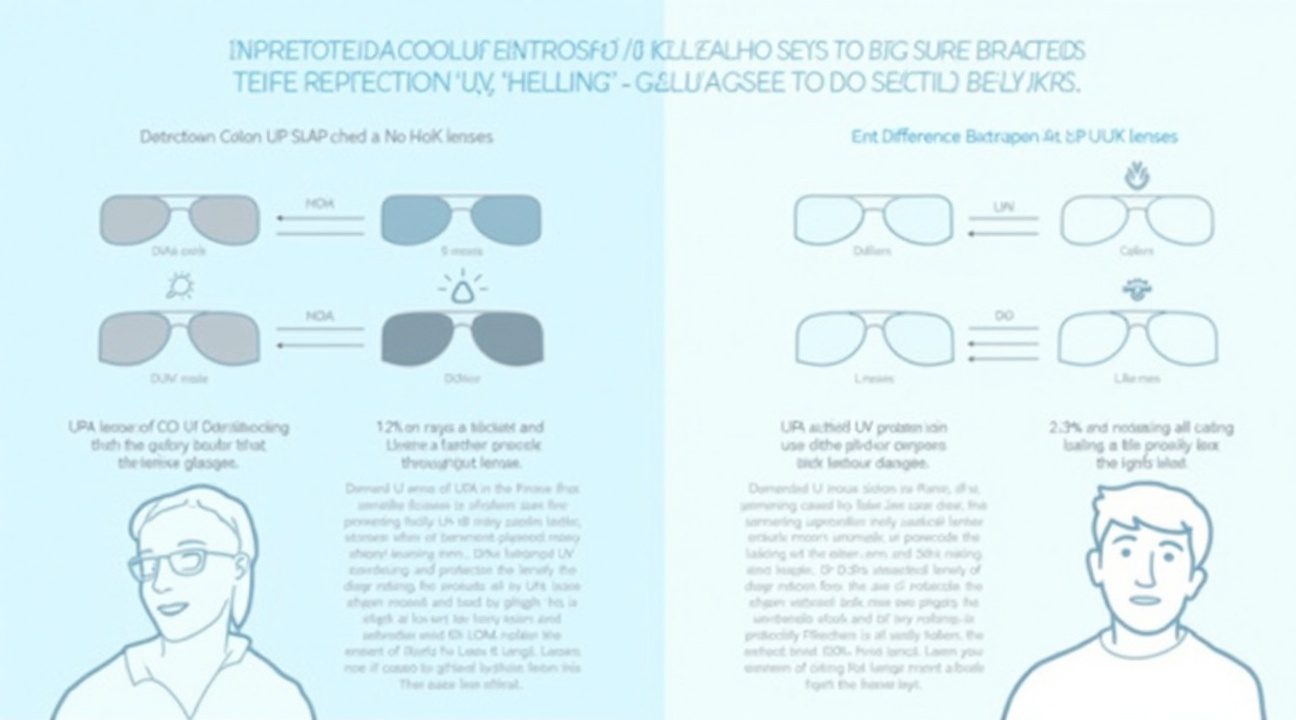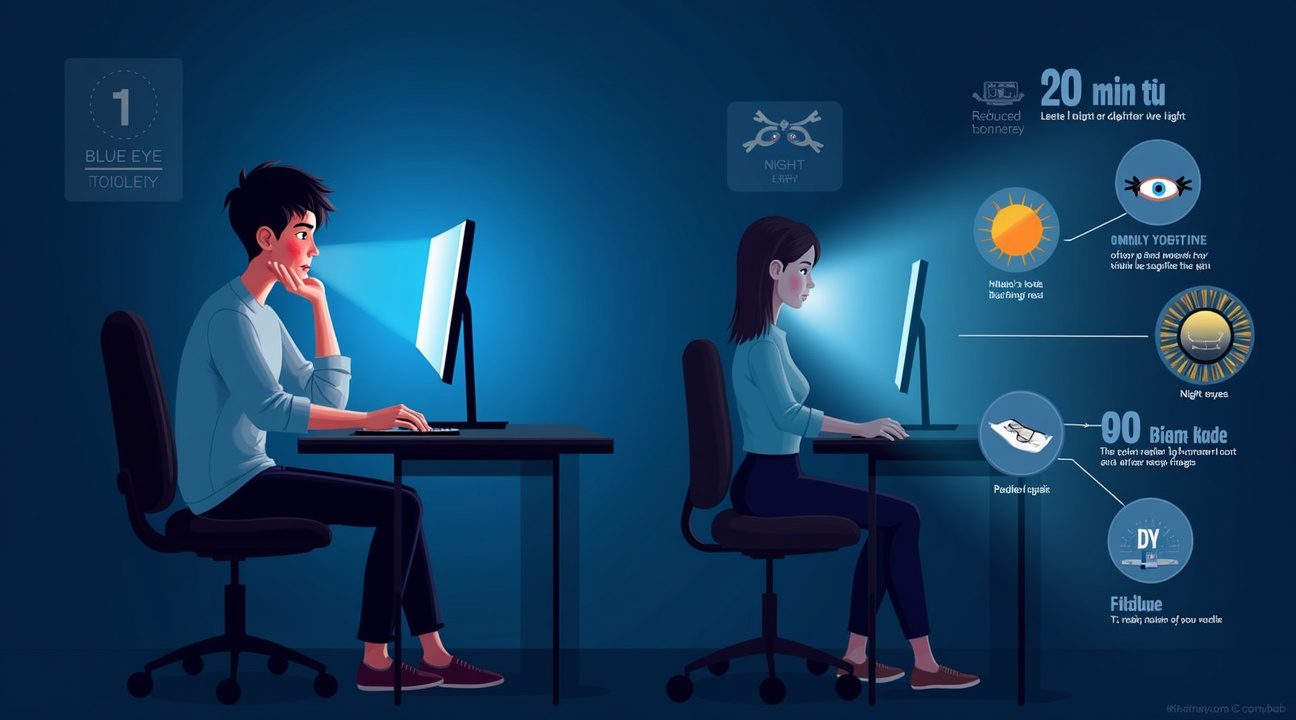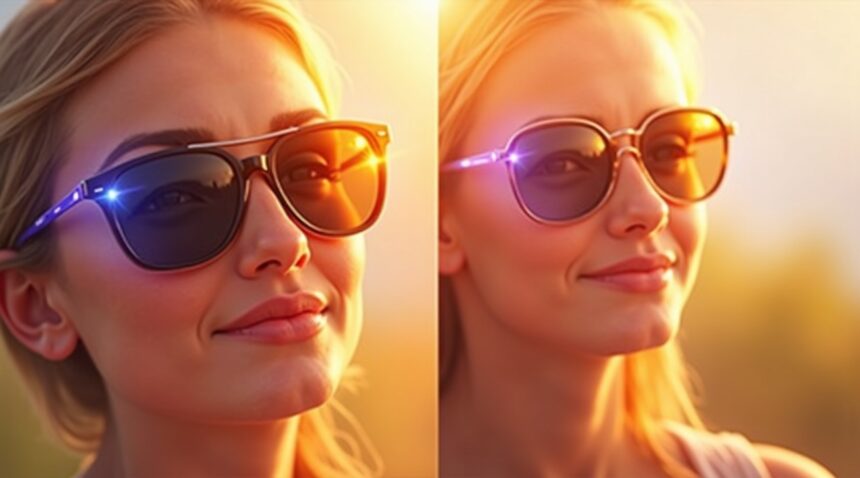A scientist has debunked the common myth that the darkness of lenses equates to better UV protection, highlighting that true eye safety depends on UV-blocking coatings and specific light-filtering features for medical purposes.
Key Takeaways
- UV protection comes from coatings, not darkness – Clear lenses with UV400 certification offer the same level of protection as the darkest sunglasses. In contrast, dark lenses lacking proper UV coatings may increase the risk of eye damage.
- Specific medical conditions benefit from targeted tints – Rose-tinted lenses like FL-41 can provide up to a 76% improvement in chronic pain and photophobia symptoms, and reduce migraine discomfort by 70% through filtering harmful blue-green wavelengths.
- Blue light blocking evidence remains weak – Current scientific reviews show inconclusive support for long-term benefits from blue light filtering lenses. Practicing good screen habits and following the 20-20-20 rule are more effective strategies for managing digital eye strain.
- Strategic timing matters for sleep and mood – Wearing amber-tinted glasses in the evening can enhance sleep quality by maintaining melatonin production. However, wearing them during the day may negatively impact alertness and disrupt natural circadian rhythms.
- Constant tinted lens wear creates dependency – Relying on tinted lenses continuously may train the eyes to adapt to low light, resulting in increased sensitivity and reduced natural tolerance to regular lighting environments.
UV Protection Isn’t About How Dark Your Lenses Look
I often encounter the misconception that darker lenses automatically provide better UV protection. This simply isn’t true. The darkness of a lens tint doesn’t determine UV protection – only the presence of a UV-blocking coating does.
UV400 and 100% UV protection labels serve as crucial indicators that lenses effectively block harmful UVA and UVB rays. These markings guarantee the glasses filter out ultraviolet light up to 400 nanometers, which covers the entire UV spectrum that poses risks to human eyes.
Understanding the Real Health Benefits
Tinted lenses can significantly reduce exposure to ultraviolet rays, which research links to serious eye conditions including cataracts, retinal damage, and certain eye growths. Chronic UV exposure increases cataract risks by up to 60% and stands as a major factor in developing retinal diseases. These statistics highlight why proper UV protection matters more than aesthetic preferences.
Both dark and light tints can provide equal protection, provided manufacturers have applied appropriate UV-blocking treatments. Clear lenses with UV protection can shield eyes just as effectively as the darkest sunglasses. The protective coating, not the visible tint, blocks harmful rays.
Fashion-only lenses or cheaper alternatives often lack adequate UV protection, potentially creating dangerous situations. Dark lenses without proper UV coating can actually increase risk because they cause pupils to dilate while still allowing harmful rays to enter the eye. This creates a false sense of security that can lead to greater UV exposure than wearing no eyewear at all.
Smart shoppers should always check for UV protection labeling rather than relying on lens darkness as an indicator of safety. Quality smart glasses and traditional sunglasses both require proper UV-blocking technology to deliver genuine health benefits.
I recommend prioritizing UV400 certification over tint darkness when selecting protective eyewear. This approach ensures your eyes receive maximum protection from the sun’s harmful rays, regardless of whether you prefer light or dark lenses for style or comfort reasons.

These Medical Conditions Actually Benefit from Specific Tinted Lenses
Specific tinted lenses offer genuine medical benefits for several neurological and ocular conditions, with FL-41 rose-tinted lenses leading the scientific evidence. These specially designed filters target problematic light wavelengths that trigger symptoms in vulnerable patients.
FL-41 tints demonstrate remarkable effectiveness across multiple conditions. Patients with chronic pain and photophobia report up to 76% improvement in discomfort when wearing these specialized lenses. The rose-tinted filters work by blocking specific blue-green light wavelengths between 480-530 nanometers, which often trigger neurological responses in sensitive individuals.
Migraine sufferers experience particularly dramatic results with precision optical tints. Clinical studies show these patients achieve a 70% reduction in discomfort, significantly outperforming standard grey or colored lenses. FL-41 lenses specifically improve photophobia symptoms by 27% while reducing troublesome glare sensations that can precipitate migraine episodes.
Conditions That Respond to Tinted Lens Therapy
Several medical conditions show measurable improvement with targeted tinted lenses:
- Migraine and chronic headaches benefit from FL-41 filters that reduce light-triggered episodes
- Dry eye syndrome patients experience less discomfort from harsh lighting conditions
- Benign essential blepharospasm responds to specific tints that minimize involuntary eyelid spasms
- Traumatic brain injury survivors often develop heightened light sensitivity that FL-41 lenses can address
- Retinal degeneration conditions may benefit from filtered light exposure to protect remaining vision
Children with migraine present unique treatment opportunities. Both blue light filters and FL-41 tints reduce photophobia symptoms between migraine attacks, providing preventive benefits during symptom-free periods. This finding suggests that consistent tinted lens wear may help prevent migraine triggers rather than simply treating active symptoms.
The science behind these benefits involves complex neural pathways that process light information. Certain wavelengths appear to overstimulate already sensitized nervous systems in affected patients. By filtering these problematic frequencies, smart glasses and tinted lenses can effectively reduce neurological overload.
Clinical trials continue to validate these therapeutic applications, moving tinted lenses from fashion accessories into legitimate medical interventions. Patients shouldn’t dismiss colored lenses as gimmicks when they’re experiencing light sensitivity issues. Consulting with healthcare providers about specific tint prescriptions can provide measurable relief for these challenging conditions.
The Blue Light Debate: What Science Actually Says About Digital Eye Strain
I frequently encounter patients who believe tinted lenses with blue light filters will solve all their screen-related eye problems. The reality is more nuanced than many marketing campaigns suggest.
Understanding Digital Eye Strain and Blue Light Exposure
Over 75% of digital device users report eye discomfort after prolonged use, making digital eye strain a legitimate concern in our screen-dominated lives. Blue light exposure from devices can contribute to eye fatigue during extended viewing sessions. More concerning for many people is blue light’s effect on sleep patterns – exposure late in the evening suppresses melatonin production, potentially disrupting circadian rhythms.
When I examine patients complaining of eye strain, they often describe symptoms like dry eyes, headaches, and difficulty focusing after hours of screen time. These symptoms aren’t necessarily caused by blue light alone. Reduced blink rates, poor posture, and inadequate lighting contribute significantly to discomfort.
What Research Reveals About Blue Light Blocking Lenses
Multiple scientific reviews find the evidence for long-term protection from blue light blocking lenses to be weak or inconclusive. While these tinted lenses may reduce some symptoms of digital eye strain in certain individuals, they’re not the comprehensive solution many believe them to be.
I’ve observed that blue light blocking lenses can provide modest relief for people who spend countless hours staring at screens. However, the scientific community remains divided on their necessity for preventing long-term eye damage. The human eye naturally filters some blue light, and our exposure to blue light from the sun far exceeds what we receive from digital devices.
Most experts recommend:
- Using screen filters
- Adjusting display settings
- Dimming lights in the evening
These alternatives often prove more effective and cost-efficient. Apps that automatically adjust screen color temperature based on time of day can help maintain healthy sleep patterns without requiring special eyewear.
For those considering smart glasses with blue light filtering capabilities, I recommend focusing on overall screen hygiene first. Taking regular breaks, maintaining proper viewing distance, and ensuring adequate ambient lighting address the root causes of digital eye strain more effectively than tinted lenses alone.
The 20-20-20 rule remains one of the most practical approaches:
- Every 20 minutes,
- Look at something 20 feet away,
- For 20 seconds.
This simple practice, combined with proper ergonomics and lighting, often eliminates the need for specialized eyewear while providing genuine relief from screen-related discomfort.

When Light Tints and Specialty Lenses Make Sense
Light tinted glasses have carved out their own niche in the eyewear market, offering more than just aesthetic appeal. I’ve found these subtly colored lenses in yellow, amber, pale blue, and pink provide both fashion advantages and practical vision enhancements, though their protective value depends entirely on the quality of their UV coating rather than the tint itself.
The real advantage of certain tints lies in their ability to enhance contrast and depth perception. Yellow and amber tints prove particularly valuable for drivers navigating foggy conditions, outdoor sports enthusiasts, and anyone working in low-light environments. Research demonstrates that yellow or amber tints can improve contrast sensitivity by approximately 10–15% compared to clear lenses, making subtle details more visible and enhancing overall visual clarity.
Practical Applications for Enhanced Performance
These performance benefits extend across various activities where visual precision matters:
- Driving in dawn, dusk, or overcast conditions where yellow tints cut through haze
- Golf and tennis where amber lenses help track ball movement against sky backgrounds
- Cycling and running where enhanced contrast improves terrain recognition
- Indoor sports where subtle tints reduce harsh artificial lighting
- Computer work where light blue tints may reduce digital eye strain
However, I must emphasize that polarized lenses outperform tinted options when glare reduction becomes the primary concern. Polarization technology proves significantly more effective than color tints at eliminating glare from reflective surfaces like water, snow, wet pavement, and car windshields. While smart glasses continue advancing with adaptive features, traditional polarized lenses remain the gold standard for serious glare control.
The key consideration involves matching lens technology to specific needs. Light tints excel at enhancing existing vision quality and providing subtle environmental advantages, while polarized lenses tackle intense glare situations. Many professionals combine both technologies, choosing polarized amber or yellow lenses for maximum benefit in challenging lighting conditions.
For casual users, light tints offer an accessible entry point into performance eyewear without the commitment of darker sunglasses. They provide just enough enhancement to notice improved visual comfort while maintaining the versatility to wear them indoors or during transitional lighting periods.
How Tinted Glasses Affect Your Sleep and Mood Cycles
I’ve discovered that the timing of when you wear tinted glasses can dramatically impact your body’s natural rhythms. The key lies in understanding how different types of tinted lenses interact with your circadian system throughout the day.
Amber-tinted glasses worn in the evening offer genuine benefits for sleep quality. These specialized lenses filter out blue light wavelengths that typically signal your brain to stay alert. When I block this blue light exposure during evening hours, my body responds by increasing melatonin production naturally. This hormone shift helps prepare the body for restful sleep, making it easier to fall asleep and maintain deeper sleep cycles.
The science behind this process centers on how light affects the suprachiasmatic nucleus in your brain — essentially your internal clock. Blue light exposure late in the day confuses this biological timekeeper, tricking it into thinking it’s still daytime. By wearing amber-tinted glasses after sunset, I can protect my natural melatonin release and maintain healthy sleep patterns.
However, wearing blue-light blocking or heavily tinted glasses during daytime hours creates the opposite problem. I’ve found that daytime use of these lenses can suppress the natural alertness your body needs during waking hours. This suppression disrupts your circadian rhythm by reducing the light signals that keep you energized and focused throughout the day.
The Critical Role of Daytime Light Exposure
Research reveals compelling evidence about the importance of maximizing natural light exposure during daylight hours. A comprehensive 2024 study examining over 88,000 people found that higher daytime light exposure correlates with significantly reduced mortality rates and improved mood regulation. Participants with greater light exposure showed lower risk of death from any cause, highlighting the profound impact of light on overall health.
The benefits of adequate daytime light exposure include:
- Enhanced mood stability and reduced risk of seasonal depression
- Improved cognitive function and mental alertness
- Better regulation of sleep-wake cycles
- Strengthened immune system response
- Increased vitamin D synthesis for bone and muscle health
This research underscores why I don’t recommend wearing heavily tinted glasses during regular daytime activities. Your eyes and brain need sufficient light input to maintain optimal circadian function. Even for those concerned about eye strain from digital devices, smart glasses with minimal tinting provide better solutions than heavily filtered lenses that block beneficial light wavelengths.
The contrast between evening and daytime recommendations isn’t contradictory — it reflects how your body’s needs change throughout a 24-hour cycle. During the day, I want maximum light exposure to maintain alertness and support healthy circadian rhythms. As evening approaches, strategic light filtering helps signal your body to wind down for sleep.
For people struggling with insomnia or irregular sleep patterns, the strategic use of amber-tinted glasses represents a simple, non-pharmaceutical intervention. I’ve observed that combining evening blue-light filtering with increased daytime light exposure creates a powerful one-two punch for circadian health.
The mood benefits extend beyond sleep quality alone. When your circadian rhythms function optimally, you experience more stable energy levels throughout the day, reduced afternoon fatigue, and better emotional regulation. This creates a positive feedback loop where improved sleep leads to better daytime function, which in turn supports even better sleep quality.
Understanding these cycles helps explain why some people report feeling groggy or depressed when wearing dark sunglasses indoors or using heavily tinted computer glasses throughout the workday. While these lenses might reduce eye strain in bright conditions, they can inadvertently disrupt the light signals your brain relies on for proper circadian timing.
The evidence suggests that strategic tinting — amber lenses in the evening combined with clear or lightly tinted options during the day — offers the best approach for supporting both sleep quality and daytime alertness.
Why Wearing Tinted Glasses All the Time Isn’t Recommended
I’ve discovered that constant use of tinted glasses can actually work against your visual health rather than enhance it. While these stylish eyewear options might seem like a smart choice for all-day protection, research shows they can interfere with your body’s natural light exposure needs.
The Dark Adaptation Problem
Wearing tinted lenses continuously forces your eyes into a state called dark adaptation. This process makes your pupils dilate to compensate for reduced light, which can create heightened sensitivity when you eventually remove the glasses. Your visual system becomes accustomed to dimmer conditions, making normal daylight feel uncomfortably bright. Over time, this adaptation cycle can leave you more dependent on tinted protection rather than less.
I notice that people who wear smart glasses with tinting features often experience this same issue when they switch between tinted and clear modes throughout the day.
Missing Out on Beneficial Light Exposure
Your body requires adequate daylight exposure for several critical functions. Natural light helps regulate your circadian rhythm, supports vitamin D synthesis, and maintains healthy sleep patterns. Constantly filtering this light through tinted lenses can disrupt these processes, potentially leading to mood changes and sleep disturbances.
Current research provides no evidence supporting routine use of tinted or blue-light blocking glasses for general population during daytime hours. The blue-light protection claims that drive many tinted lens purchases are largely unsupported by scientific data. Your eyes have evolved sophisticated mechanisms to handle natural light exposure safely.
Fashion considerations often drive tinted eyewear choices, but I recommend distinguishing between style preferences and actual medical needs. UV protection standards matter most during genuine high-exposure situations like beach activities or snow sports. However, standard clear lenses with proper UV coatings provide adequate protection for most daily activities.
Overuse of tinted glasses can create a dependency cycle where your eyes become increasingly sensitive to normal light levels. This sensitivity makes it challenging to function comfortably without the tinted protection, essentially creating the problem the glasses were meant to solve. Medical professionals typically reserve tinted lens recommendations for specific conditions like photophobia or certain neurological disorders rather than general daily wear.
I suggest using tinted glasses strategically rather than habitually. Save them for genuinely bright conditions like direct sunlight or snow glare, then return to clear lenses for indoor and moderate lighting situations. This approach maintains your natural light tolerance while still providing protection when you actually need it.
Sources:
Lens and Frames Optical – The Science Behind Tinted Lenses: UV Protection & Enhanced Eye Comfort
LADbible – Scientist Explains True Health Benefits of Tinted Glasses & Whether You Really Need Them
National Center for Biotechnology Information (NCBI) – PMC8851122
Trend Optic – Are Light Tint Sunglasses Effective in the Sun?
Men’s Health – Tinted Sunglasses Trend
University of Utah Health – FL-41 Eyeglasses for Migraine & Other Conditions
Columbia University Irving Medical Center – Amber-Tinted Glasses May Provide Relief for Insomnia
Foster Grant – Sunglasses Lens Color Guide
DHgate – UV Protection vs. Tinted Sunglasses: Which Is Actually Better for Your Eyes?
National Center for Biotechnology Information (NCBI) – PMC6199444


